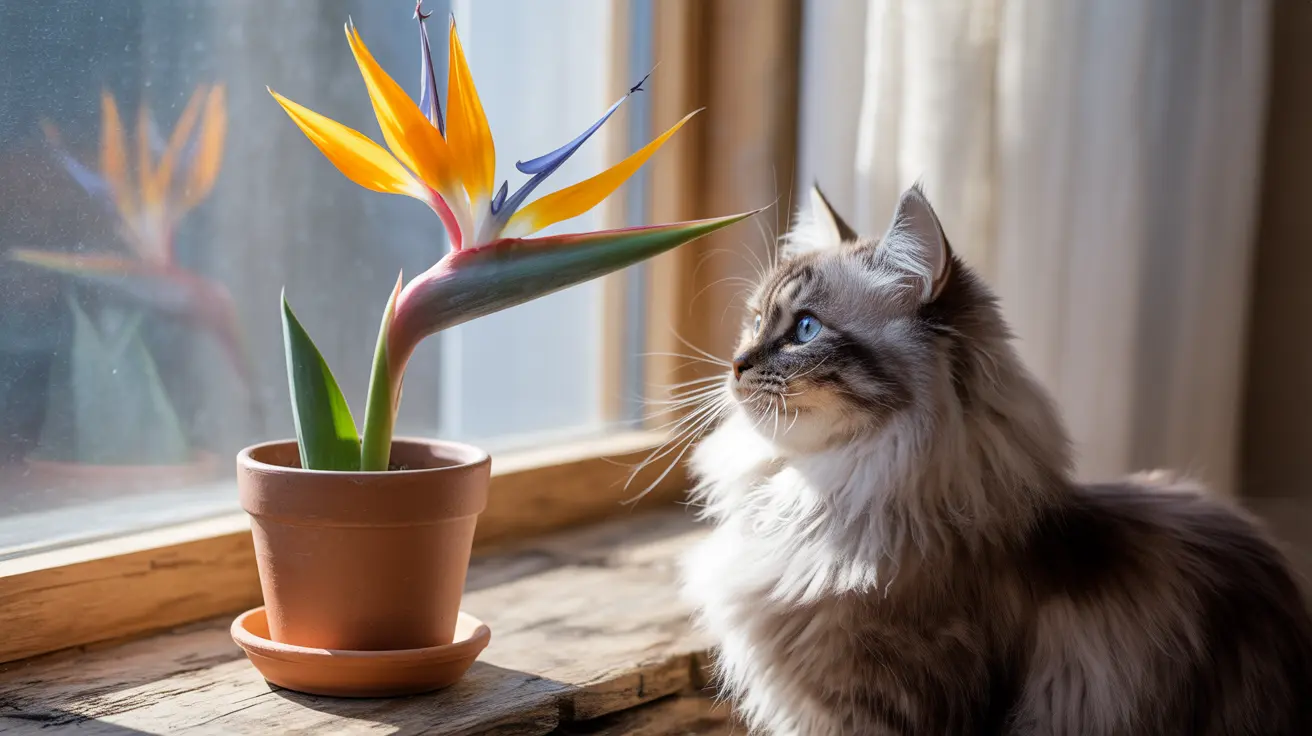Understanding Bird of Paradise Plants and Cat Safety
The Bird of Paradise plant (Strelitzia reginae) is a stunning tropical houseplant known for its distinctive bird-like flowers. While its exotic appearance makes it a popular choice for home decor, cat owners should be aware that this plant is mildly toxic to their feline friends.
Understanding the risks associated with Bird of Paradise plants is crucial for maintaining your cat's safety while enjoying these beautiful specimens in your home. This comprehensive guide will explore the plant's toxicity levels, symptoms to watch for, and practical safety measures for pet parents.
Toxicity Levels and Dangerous Components
The Bird of Paradise plant contains several compounds that can be harmful to cats:
- Tannins in the seeds that interfere with protein digestion
- Hydrocyanic acid in the leaves that can disrupt oxygen utilization
- Gastrointestinal irritants present throughout the plant
The seeds and fruits pose the highest risk to cats, while other parts of the plant typically cause milder reactions. It's important to note that this plant's toxicity is generally considered mild, rarely resulting in severe or life-threatening situations.
Recognizing Symptoms of Bird of Paradise Poisoning
If your cat has ingested any part of a Bird of Paradise plant, symptoms typically appear within 20 minutes to a few hours. Common signs include:
- Vomiting and diarrhea
- Oral irritation and discomfort
- Decreased appetite or complete loss of appetite
- Lethargy and confusion
- Mild breathing difficulties
- Eye discharge in some cases
Most cats experience only mild to moderate symptoms that resolve within 24 hours. However, monitoring your pet closely and seeking veterinary care if symptoms persist or worsen is essential.
Prevention and Safe Plant Ownership
To safely keep Bird of Paradise plants in a home with cats:
- Place plants in rooms cats cannot access
- Use hanging planters or high shelves out of jumping reach
- Consider protective barriers around the plant
- Regular training to discourage plant chewing
- Provide cat-safe alternatives like cat grass
The best prevention is to keep these plants completely out of reach or consider pet-friendly alternatives if you have particularly curious cats.
Emergency Response and Treatment
If you suspect your cat has ingested any part of a Bird of Paradise plant:
- Remove any plant material from your cat's mouth if possible
- Document the amount and part of plant consumed
- Contact your veterinarian or animal poison control immediately
- Monitor your cat's symptoms and behavior
- Keep the ASPCA Poison Control number (888-426-4435) handy
Frequently Asked Questions
Is the Bird of Paradise plant toxic to cats and what symptoms should I watch for?
Yes, Bird of Paradise is mildly toxic to cats. Watch for symptoms including vomiting, diarrhea, oral irritation, decreased appetite, and lethargy. Most cases are mild and resolve within 24 hours.
Which parts of the Bird of Paradise plant are most dangerous for cats to ingest?
The seeds and fruits are the most toxic parts, containing higher concentrations of harmful compounds like tannins. However, all parts of the plant can cause gastrointestinal irritation if ingested.
How quickly do symptoms appear in cats after eating Bird of Paradise, and are they usually severe?
Symptoms typically appear within 20 minutes to a few hours after ingestion. They are usually mild to moderate and rarely severe, though immediate veterinary attention is recommended if significant amounts are consumed.
How can I safely keep Bird of Paradise plants in a home with curious cats?
Place plants in inaccessible locations, use hanging planters, or create barriers around the plants. Consider pet-safe alternatives if your cats are particularly interested in plants.
What should I do if my cat eats part of a Bird of Paradise plant?
Contact your veterinarian or animal poison control immediately, remove any remaining plant material from your cat's mouth, and monitor their symptoms. Keep the ASPCA Poison Control number handy for emergencies.






